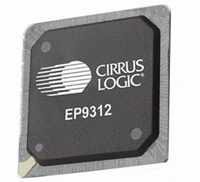EP9312-CB Cirrus Logic Inc, EP9312-CB Datasheet - Page 41

EP9312-CB
Manufacturer Part Number
EP9312-CB
Description
System-on-Chip Processor
Manufacturer
Cirrus Logic Inc
Series
EP9r
Datasheets
1.EP9307-CRZ.pdf
(824 pages)
2.EP9312-IBZ.pdf
(4 pages)
3.EP9312-CB.pdf
(62 pages)
4.EP9312-CB.pdf
(17 pages)
Specifications of EP9312-CB
Peak Reflow Compatible (260 C)
No
A/d Converter
12 Bits
Leaded Process Compatible
No
No. Of I/o Pins
65
Package / Case
352-BGA
Core Processor
ARM9
Core Size
16/32-Bit
Speed
200MHz
Connectivity
EBI/EMI, EIDE, Ethernet, I²C, IrDA, Keypad/Touchscreen, SPI, UART/USART, USB
Peripherals
AC'97, DMA, I²:S, LCD, LED, MaverickKey, POR, PWM, WDT
Number Of I /o
16
Program Memory Type
ROMless
Ram Size
32K x 8
Voltage - Supply (vcc/vdd)
1.65 V ~ 3.6 V
Data Converters
A/D 8x12b
Oscillator Type
External
Operating Temperature
0°C ~ 70°C
Processor Series
EP93xx
Core
ARM920T
Data Bus Width
32 bit
3rd Party Development Tools
MDK-ARM, RL-ARM, ULINK2
Lead Free Status / RoHS Status
Contains lead / RoHS non-compliant
Eeprom Size
-
Program Memory Size
-
Lead Free Status / Rohs Status
No
Other names
598-1257
Available stocks
Company
Part Number
Manufacturer
Quantity
Price
Part Number:
EP9312-CB
Manufacturer:
CIRRUS
Quantity:
20 000
- EP9307-CRZ PDF datasheet
- EP9312-IBZ PDF datasheet #2
- EP9312-CB PDF datasheet #3
- EP9312-CB PDF datasheet #4
- Current page: 41 of 824
- Download datasheet (13Mb)
DS785UM1
2.2.3.1 ARM9TDMI Core
A 16 kbyte instruction and a 16 kbyte data cache are included to increase performance for
cache-enabled memory regions. The 64-way associative cache also has lock-down
capability. A 16-word Write Buffer allows cached instructions to be fetched and decoded while
the Write Buffer sends data to external memory.
The ARM920T Core supports a number of co-processors, including the MaverickCrunch co-
processor by means of a specific pipeline architecture interface.
ARM9TDMI core is responsible for executing both 32-bit ARM and 16-bit Thumb instructions.
Each provides a unique advantage to a system design. Internally, the instructions enter a 5-
stage pipeline. These stages are:
All instructions are fully interlocked. This mechanism will delay the execution stage of a
instruction if data in that instruction comes from a previous instruction that is not available yet.
This simply insures that software will function identically across different implementations.
For memory access instructions, the base register used for the access will be restored by the
ARM Core in the event of an Abort exception. The base register will be restored to the value
contained in it immediately before execution of the instruction.
The ARM9TDMI core memory interface includes a separate instruction and data interface to
allow concurrent access of instructions and data to reduce the number of CPI (cycles per
instruction). Both interfaces use pipeline addressing. The core can operate in big and little
endian mode. Endianess affects both the address and the data interfaces.
The memory interface executes four types of memory transfers: sequential, non-sequential,
internal, and co-processor. It will also support uni- and bi-directional transfer modes.
The core provides a debug interface called JTAG (Joint Testing Action Group). This interface
provides debug capability with five external control signals:
There are six scan chains (0 through 5) in the ARM9TDMI controlled by the JTAG Test
Access Port (TAP) controller. Details on the individual scan chain function and bit order can
be found in the ARM920T Technical Reference Manual.
• Instruction Fetch
• Instruction Decode
• Execute
• Data Memory Access
• Register Write
• TDO - Test Data Out
• TDI - Test Data In
• TMS - Test Mode Select
• TCK - Test Clock
• nTRST - Test Reset
Copyright 2007 Cirrus Logic
ARM920T Core and Advanced High-Speed Bus (AHB)
EP93xx User’s Guide
2-3
2
Related parts for EP9312-CB
Image
Part Number
Description
Manufacturer
Datasheet
Request
R

Part Number:
Description:
IC ARM920T MCU 200MHZ 352-PBGA
Manufacturer:
Cirrus Logic Inc
Datasheet:

Part Number:
Description:
IC ARM9 SOC UNIVERSAL 352PBGA
Manufacturer:
Cirrus Logic Inc
Datasheet:

Part Number:
Description:
IC ARM920T MCU 200MHZ 352-PBGA
Manufacturer:
Cirrus Logic Inc
Datasheet:

Part Number:
Description:
IC Universal Platform ARM9 SOC Prcessor
Manufacturer:
Cirrus Logic Inc
Datasheet:

Part Number:
Description:
IC Universal Platform ARM9 SOC Prcessor
Manufacturer:
Cirrus Logic Inc
Datasheet:

Part Number:
Description:
Development Kit
Manufacturer:
Cirrus Logic Inc
Datasheet:

Part Number:
Description:
Development Kit
Manufacturer:
Cirrus Logic Inc
Datasheet:

Part Number:
Description:
High-efficiency PFC + Fluorescent Lamp Driver Reference Design
Manufacturer:
Cirrus Logic Inc
Datasheet:

Part Number:
Description:
Development Kit
Manufacturer:
Cirrus Logic Inc
Datasheet:

Part Number:
Description:
Development Kit
Manufacturer:
Cirrus Logic Inc
Datasheet:

Part Number:
Description:
Development Kit
Manufacturer:
Cirrus Logic Inc
Datasheet:

Part Number:
Description:
Development Kit
Manufacturer:
Cirrus Logic Inc
Datasheet:

Part Number:
Description:
Ref Bd For Speakerbar MSA & DSP Products
Manufacturer:
Cirrus Logic Inc












